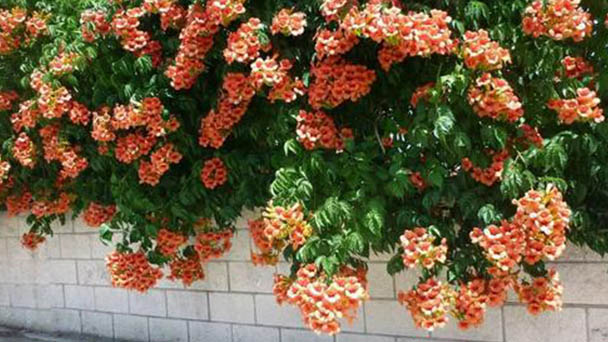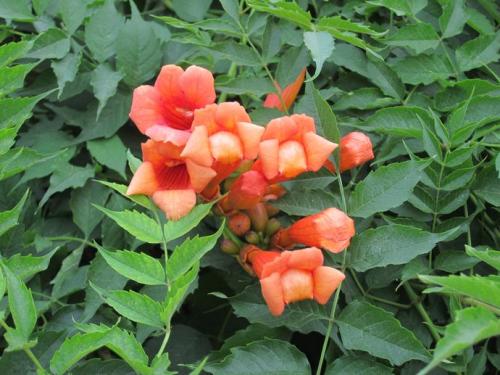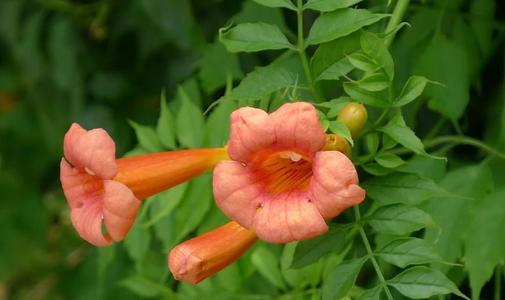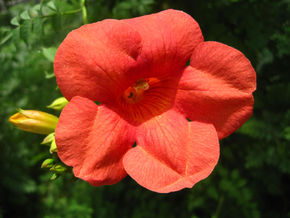Trumpet vine (Campsis radicans) profile
Written by Maggie
Mar 11 2021

Trumpet Vine (Campsis radicans), also called trumpet creeper, is a plant in the genus Vladivostok in the Vladivostok family. Trumpet Vine originates from North America.Distribution in Pakistan, Vietnam, India and mainland China Hunan, Guangxi, Zhejiang, Jiangsu Hunan and other places cultivation for garden ornamental plants; It is also cultivated in Vietnam, India and Pakistan.Henan parks are also cultivated.
Trumpet vine picture

Trumpet vine info
| Botanical Name | Campsis radicans |
| Common Names | Trumpet vine, trumpet creeper, cow itch vine, hummingbird vine |
| Plant Type | Vine |
| Sun | Full, partial |
| Hardiness Zones |
4–9 (USDA) |
| Flower color | Orange, red, yellow |
| Native Area | North America |
| Mature size | 25–40 ft. long, 5–10 ft. wide |
Morphological characteristics of trumpet vine
Trumpet vine is a deciduous vine with aerial roots; Leaves are pinnate, 7-15 leaflets, elliptic to ovate-elliptic, 3 -- 6cm long and 2 -- 4cm wide, apically caudate acuminate, basally cuneate, margin toothed, smooth, abaxially densely white pilose along midvein. Cymes are terminal; Calyx is campanulate, thick, orange-yellow, smooth, 2 -- 3cm long, 5-lobed, sepals triangular ovate, apex acuminate, slightly curling outward, calyx tube without edges; Corolla of Trumpet Vine is funnel-shaped, 6 -- 9cm long, yellowish red, 4 -- 5cm in diameter, corolla lobes orange red.
Trumpet Vine has 9-11 leaflets, elliptic to ovate-elliptic, 3.5-6.5 cm long and 2-4 cm wide, apically caudate acuminate, basally cuneate, margin dentate, dark green above, pale green below, hairy, pubescent at least along middle rib. Calyx is campanulate, ca. 2 cm long, mouth ca. 1 cm in diameter, 5-lobed to 1/3 of a calyx tube, lobes dentate-ovate-triangular, outwardly curls, without raised longitudinal ribs. Corolla tube is slender, funnel-shaped, orange-red to red, tube 3 times as long as calyx, ca. 6-9 cm, ca. 4 cm in diameter. Capsule of Trumpet Vine is cylindrical, 8-12 cm long, apically beaked, keeled along sutures, ca. 2 mm thick, stipulate, crusty. Trumpet Vine is native to America.South China, Southeast Asia widely cultivated.
Ecological Habits of trumpet vine
Trumpet Vine prefers light, slightly shade tolerant, warm, moist, tolerably cold. Trumpet Vine is drought resistance, also more resistant to water and moisture. The soil requirements are not strict, and the sprout tillering is strong. Loose and well-drained soil is preferred.
How to grow and care for trumpet vine
Light
Trumpet vines can develop in full solar to partial shade. But full sun, that means at least six hours of direct daylight on most days, will produce the fantastic flowering.
Soil
Trumpet vines can tolerate a large variety of soil types, such as sandy, loamy, and clay soils. They do nice when they have sharp soil drainage.
Water
Trumpet vines like an average quantity of soil moisture however have correct drought tolerance. In general, they solely want watering when there are apparent signs and symptoms of wilt and withering. In most climates, the standard rainfall will be enough to maintain the plant life healthy.
Temperature and humidity
Trumpet vines’ herbal variety is the hot, humid Southeastern United States. And it is pretty hard to reach the heat and bloodless climate of its developing zones. In much less humid climates, the vine isn't always as energetic and for this reason is less difficult to control.
Fertilizer
Because trumpet vines are such aggressive spreaders and can thrive in lean soil, no supplemental fertilization is recommended.
Pruning
It is nearly not possible to prune this plant too much due to its vigor. Trumpet vines bloom on new stems, so prune early in the spring earlier than boom starts. Cut the plant again to almost floor level, leaving solely a few buds. This sort of aggressive annual pruning is the quality way to maintain the plant in check.

Trumpet vine toxicity
All components of the trumpet vine, inclusive of its seeds and sap, are poisonous each to human beings and animals. Toxicity can show up from ingestion and by means of pores and skin contact. This is how the plant acquired one of its frequent names: cow itch vine.
Trumpet vines symptoms of poisoning
From pores and skin contact, trumpet vines can cause moderate to extreme rashes, itchiness, redness, and infection on each human being and animals. Thus, it is continually endorsed to use defensive garb when working with the plant. When ingested, the vines can cause upset stomach, nausea, vomiting, and diarrhea. If you suspect poisoning, contact a scientific expert as quickly as possible.
Trumpet vine varieties
There are a number of trumpet vine varieties, including:
Campsis radicans 'Apricot': This range is fairly extra compact and much less invasive than the primary species plant, and it produces apricot coloured blooms.
Campsis radicans 'Flava': This range facets showy golden vegetation that stretch round three inches long.
Campsis radicans 'Indian Summer': This is a particularly hardy range and sports activities yellow-orange blooms.
Trumpet vine propagation
Trumpet vine is commonly used for planting, cutting, layering, and planting.
The distribution area of trumpet vine
Trumpet Vine originated in the Americas and is cultivated domestically as an ornamental plant in Guangxi, Jiangsu, Zhejiang, and Hunan. It is also cultivated in Vietnam, India and Pakistan.
Uses of trumpet vine
Medical value
trumpet vine can be medicine, vertical greening materials. Flowers can be used for trumpet vine medicine, leaves containing caffeic acid, coumaric acid and ferulic acid.
The courtyard role
Trumpet vine is a good plant for gardening, with lush foliage, bright flowers and beautiful shapes.

Latest Updated
- Benefits of Bugleweed - 7 Science-backed Health Benefits
- Bugleweed Dangers & Side Effects - Is It Poisonous?
- How to Plant Evergreen Trees - What You Should Know
- When to Plant Evergreens - Grow Guide for Evergreen Trees
- 12 Wonderful Evergreen Shrubs for Your Garden
- 12 Popular Evergreen Plants with Pictures for Beginners
- When And How To Prune A Lilac Bush Like a Pro
- How to Grow & Care for Lilac Vine (Hardenbergia Violacea)
- Japanese Lilac Tree (Syringa Reticulata) Care & Propagation Guide
- Shumard Oak Pros and Cons - What to Know
Popular Articles
- Winter maintenance of Antirrhinum Majus
- How to Grow Terminalia Mantaly Tree
- How to Grow and Care for Crossostephium Chinense
- How to grow Antirrhinum Majus in spring
- Peristeria Elata (Dove Orchid) Profile: Info & Care Guide
- Underwatered Snake Plant (Sansevieria Trifasciata) - Signs And How To Fix
- How to Care for Brazilian Jasmine Plant (Mandevilla Sanderi)
- How to Grow & Care for Graptopetalum Purple Delight in Summer
- Rosa Chinensis (China Rose): Plant Growing & Care Tips
- How to Care for Baby Sun Rose (Aptenia Cordifolia)